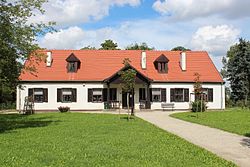Maria Dąbrowska
Maria Dąbrowska | |
|---|---|
 Maria Dąbrowska | |
| Born | 6 October 1889 Russów |
| Died | 19 May 1965 (aged 75) Warsaw, Poland |
| Language | Polish |
| Nationality | Polish |
| Notable works | Noce i dnie (Nights and Days) |

Maria Dąbrowska ([dɔmˈbrɔfska]; 6 October 1889 – 19 May 1965) was a Polish writer, novelist, essayist, journalist and playwright,[1] author of the popular Polish historical novel Noce i dnie (Nights and Days) written between 1932 and 1934 in four separate volumes. The novel was made into a film by the same title in 1975 by Jerzy Antczak.[2] Dąbrowska was awarded the prestigious Golden Laurel of the Polish Academy of Literature in 1935.
Career highlights
Dąbrowska née Szumska was born in Russów near Kalisz in central Poland under Tsarist military control.[2] Her parents belonged to the impoverished landed gentry. Maria suffered from Esotropia giving her a "cross-eyed" appearance. She studied sociology, philosophy, and natural sciences in Lausanne and Brussels, and settled in Warsaw in 1917. Interested in both literature and politics, she devoted herself to help those born into poverty. In the interwar period, Dąbrowska worked temporarily in the Polish Ministry of Agriculture while venturing more and more into newspaper reporting and public life. In 1927 she became more involved in writing about human rights. In her novels, plays and newspaper articles she analyzed the psychological consequences of hardship and life's traumas in the world of everyday citizens.
Maria née Szumska married Marian Dąbrowski who died suddenly when she was 36. Her second long-term partner was a 19-years-older Stanisław Stempowski with whom she lived in a common-law marriage until the outbreak of World War II.[2] During the occupation of Poland she stayed in Warsaw and supported the cultural life of the Polish underground. At about that time, she also met Anna and Jerzy Kowalski, two married writers. They had a child in 1946, but Jerzy died suddenly in 1948. The two women stayed in a relationship for the next 20 years, although Maria tried to get Anna married again. Dąbrowska was awarded the Order of Polonia Restituta during the Stalinist period. She died in 1965 at the age of 75 in Warsaw.[2]
Works
- Dzieci ojczyzny (Fatherland's Children), 1918
- Gałąź czereśni (The Cherry Branch), 1922
- Uśmiech dzieciństwa, 1923
- Ludzie stamtąd, 1926
- Noce i dnie (Nights and Days), 1932 - 1934 English translation fragment
- Znaki życia (The Signs of Life), 1938
- Gwiazda zaranna, 1955
References
- ^ Marcel Cornis-Pope, John Neubauer, History of the Literary Cultures of East-Central Europe: Types and stereotypes. Page 488. Benjamins Publishing, 2010. ISBN 90-272-3458-2.
- ^ a b c d Krzysztof Tomasik (October 19, 2009). "Fragment książki "Homobiografie"". Krzysztof Tomasik, Homobiografie, Wydawnictwo Krytyki Politycznej, Warszawa 2008 (in Polish). Polityka.pl. Retrieved November 17, 2012.
{{cite web}}: Italic or bold markup not allowed in:|publisher=(help)
- 1889 births
- 1965 deaths
- People from Kalisz County
- Polish nobility
- Polish women writers
- Polish diarists
- LGBT writers from Poland
- Polish women novelists
- Polish dramatists and playwrights
- Lesbian writers
- 20th-century women writers
- 20th-century Polish novelists
- LGBT dramatists and playwrights
- Women memoirists
- Women dramatists and playwrights
- Recipients of the Order of the Banner of Work
- Golden Laurel of the Polish Academy of Literature
- 20th-century dramatists and playwrights
